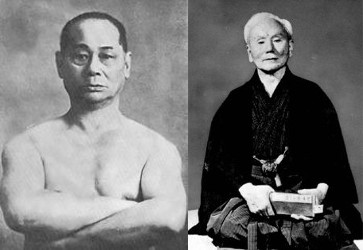
Imagine that you have two stacks of wood. One pile of very fine and straight boards, and one pile of knotty and crooked ones.
And imagine that you give these two piles of wood to two woodworkers. You give Alice the knotty and crooked wood, and Bob the nice straight boards.
Both Alice and Bob build tables with their wood. Bob builds a nice table from his nice wood. And from her poor wood, Alice builds a table that's okay. Not as nice as Bob's, but okay.
Who's the better woodworker here, Alice or Bob? Bob's table is nicer, but he started with an advantage. We could argue that though Alice finished "behind" Bob, she came a lot farther and demonstrated more skill. Of course she also had more opportunity to show skill, so we shouldn't jump to the conclusion she's the better woodworker; maybe Bob would do a little better with that crooked wood. The point is that we can't trivially judge based on final results alone, we have to consider starting points.
In the martial arts we sometimes are tempted to judge a style by the fighting prowess of its founder or a leading students. Bruce Lee fought a famous challenge match with Jack Man Wong [*] early in his career, and while the exact outcome is disputed it's part of the legend of Jeet Kun Do. Tadashi Nakamura, founder of Seido Karate (the style I study), recounts several challenge fights in his autobiography, and he is still well-known in Japan today for being part of a series of matches between Japanese karateka and Thai kickboxers (Muay Thai). Nakamura's teacher Mas Oyama is said to have fought hundreds of matches against trained fighters. These stories are part of the tradition of the Seido and Kyokushin styles of karate. Choki Motobu's 1921 match with a European boxer is another semi-legendary event that helped draw attention to karate as it was being introduced from Okinawa to "mainland" Japan.
([*] For consistency, all names in this article are given Western-style, family name last.)
On the other hand some have criticized the Shotokan style because its founder, Gichin Funakoshi, was not known for knocking people out. Indeed there was a fierce rivalry between Funakoshi and Motobu, with Funakoshi's followers portraying Motobu as an ignorant and violent lout and Motobu fans claiming that Funakoshi's karate was weak and useless, that Funakoshi was afraid to put it to the test in a "real fight".
There are certainly issues of ethics and comportment here. And it's worth noting the class differences involved in the Motobu/Funakoshi rivalry, with Motobu's family outranking Funakoshi's in the old social system of Okinawa). But I'd like to look at this rivalry from another angle.
Funakoshi is part of my lineage and I'm somewhat obligated to stick up for him, but for the sake of argument let's say that Motobu was a better fighter, that he could have mopped the floor with Funakoshi. Indeed some claim that this did actually happen, but the truth is even less clear than in the Lee/Wong fight -- at least all agree that one actually happened.
The two men were close to the same age, so it's not as if Motobu was challenging a old man past his prime. But Motobu had been a noted strongman since his youth. Some of that is a result of training, but even as a child he was so energetic and agile that he earned the nickname "Monkey". It seems that to some extent Motobu was a naturally gifted athlete.
In contrast Funakoshi was sickly child, born prematurely -- and remember that this was the 1860s, an entirely different world of medicine. He was a frail child and not expected to live long. But he credited karate with building his health -- and indeed he lived to be 88, while Motobu only made it to 74.
So what, then, is the better type of karate? That which makes a natural athlete into a strong fighter, or that which makes a sickly person healthy and (again, for the sake of argument) merely an okay fighter?
This is a question that hits home for me. I wasn't sickly as a child, but I was amazingly uncoordinated. In elementary school they sent me to special gym class, a teacher's aide would play catch with me in an attempt to develop some decent hand-eye coordination. I was years behind my peers in being able to learn to ride a bike. Any time teams were chosen for baseball or soccer or whatever, I was picked last. (Or maybe on a "good" day, second-to-last, if there was someone with asthma or really overweight to be last in line. It is a strange sort of public humiliation ritual.)
But after years of karate training, I developed above-average coordination and fitness. I'm no athletic champion but I can hold my head up.
Perhaps when we examine a martial arts school or style, we should look not just at its best fighters, but at what it does for those who start with little natural ability or talent.